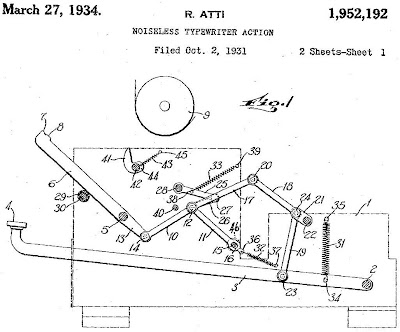An otherwise reputable golfing website says, “The dimples were arranged in a series of concentric circles surrounding the ball, much as lines of latitude on a globe. This was known as an ‘Atti Pattern’ because it mimicked the faces of an attihedron."
There is no such thing as an attihedron. What the Atti pattern is, as in the Titleist golf ball, is based on the octahedron.
And it is called the “Atti pattern” for the more simple and very obvious reason that it was invented by a man called Atti: Raphael (also known as Ralph) Atti (born of Italian parents in New York in 1900).
At the time he was inventing this golf ball, the same Raphael Atti was a persistent typewriter inventor.
On this day in 1929, Atti applied for the first of five typewriter patents all related to a noiseless typewriter. The last of these was issued in 1935.
Atti initially set out on his own in a quest to perfect the noiseless typewriter, taking up where Wellington Parker Kidder had left off 10 years earlier.
Atti then assigned two patents to Smith-Corona. He was subsequently joined in his efforts by Claude T. Rice of Brooklyn, who returned to the issue of an improved typebar action in the late 1940s. Meanwhile, the Atti noiseless typewriter project was taken up by Harry Bates of Bates Laboratory.
Of course, in the interim, Remington, which had bought the rights to Kidder’s designs, produced a Noiseless portable typewriter, which it also manufactured for Underwood – and Smith-Corona was left out in the noise.
Atti moved on to other ideas, such as a grinding machine (1931), an automobile rocking machine (1933) and a coffee roasting machine (1939). And the golf ball. He patented golf ball marking and printing machines in 1935 and 1938, a golf ball testing machine in 1942 and a golf ball winding machine in 1947.
Raphael Atti’s golf ball pattern held sway for more than 30 years. A 2009 golf ball patent application outlined the ball's place in the game's history. The first golfers in the 1800s realised that gutta-percha golf balls with damaged or indented surfaces flew better than smooth new ones. Subsequently, golf balls with brambles (bumps rather than dents), such as the Spalding Agrippa, or with grooves such as the Spalding Silvertown, were popular from the late 1800s to 1908. In 1908, William Taylor, patented a golf ball with indentations (dimples) that flew better than golf balls with brambles or grooves.
The Atti ball had 336 dimples of the same size distributed in an octahedron or so-called Atti pattern over the surface. The Atti pattern split into eight concentric straight line rows. The only other significant innovation in the first half of the 20th century came from Albert Penfold, who invented a mesh-pattern golf ball for Dunlop. This pattern was invented in 1912 and was widely accepted until Atti’s ball came along.
In 1928, the Professional Golfers' Association asked Atti, then working for the mechanical engineering company established by Frank Henry Richards in New York City, to develop a method for comparing the American golf ball to the smaller British golf ball.
Each country had its own standard for size, weight and dimple construction, and there were no standards for measuring golf ball attributes. Atti was able to determine that a ball's velocity was proportional to its compression. He showed that when equally dynamic forces are applied, a harder ball breaks away from the club faster than a softer ball. This is because the softer ball deforms, or collapses, more than the harder ball and the rubber (and other core materials) must first rebound before breaking away. Based upon this difference in response, Atti built the first golf ball compression tester to compare golf balls.
In 1948 he began his own business, Atti Engineering, in his home town of Union City, Hudson, New Jersey, manufacturing golf ball moulds, cups and compression testing machines. The family settled in Cliffside Park and Atti continued research and development on compression testing machines until he died in 1952. His son, Ralph J. Atti Jnr (born May 28, 1925), who had joined the family firm in 1946, took over the business and became a noted golf ball expert in his own right. Ralph retired in 1987, and died, aged 79, at Bergen on August 30, 2004.









No comments:
Post a Comment